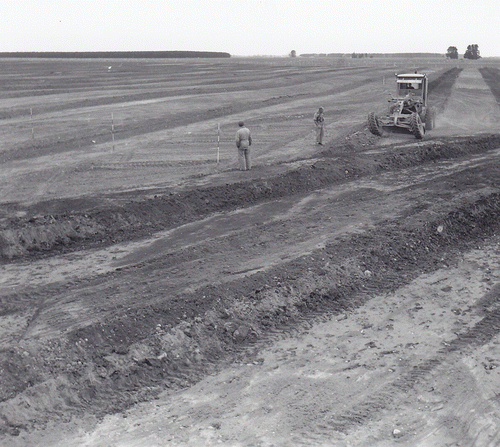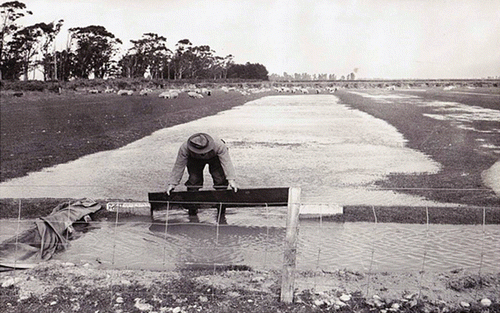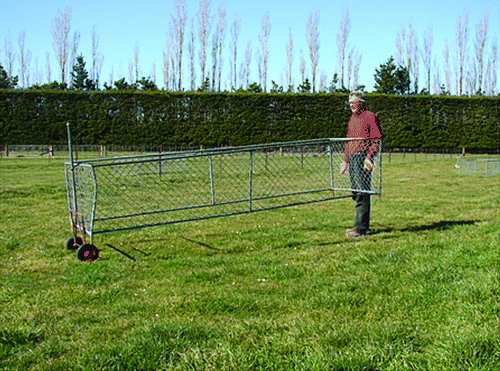Abstract
Winchmore Irrigation Research Station was established in the late 1940s in the Ashburton–Lyndhurst irrigation scheme in Canterbury, New Zealand, to investigate problems associated with the introduction of border-strip irrigation to farming. Two large-scale field trials were established. The first, in 1949, aimed to investigate water requirements of permanent pasture and the second, in 1952, to examine fertiliser requirements of irrigated pasture. Initially designed to supply farmers with practical solutions, because of their longevity (61 and 58 years to date), consistent management, meticulous record keeping and archiving of regular soil and plant samples, both trials have yielded a rich source of material for many studies, some of which are reported in other papers in this issue of the journal.
Introduction
This paper documents the history of the establishment of Winchmore, describes the soils and climate, details the experimental design and methods behind two long-term trials (pasture response to irrigation and superphosphate requirements of irrigated pasture), describes the operations at Winchmore and, finally, briefly comments on use of the long-term studies, including applications beyond the original brief. Key publications and applications of the long-term trials are also highlighted.
Establishment of Winchmore
On 30 April 1946, The Christchurch Press reported:
A proposal for the establishment of a research and experimental irrigation Station in Canterbury, for which 700-acres of Crown land near Ashburton has been suggested, has been submitted for the decision of the Cabinet, according to information received by The Press.
The statement continued:
It is believed… that the farm will contain units to demonstrate dairying under irrigation and… other aspects which may be developed later will probably include market garden crops, crops for processing and special seed production.
The property under discussion had originally been a small part of the Winchmore run of 20,000 acres (8000 ha) taken up by George Hart in October 1853. The name came from Winchmore Hill in North London where Mr Hart's father had lived. The blocks that were to become the Winchmore Irrigation Research Station had been transferred from John Hanrahan to His Majesty the King on 7 June 1945 ‘for the purpose of the Small Farms Act 1933–23 and its amendments’.
In July 1946, The Canterbury Progress League was expressing pleasure at the government's decision because the idea had long been advocated by the League and the Ashburton–Lyndhurst Irrigation Development Association.
In February 1946, Norman Lamont (Assistant Irrigation Officer in the Department of Agriculture) had written to the Director of the Fields Division of the Department in Wellington, outlining his recommendations for the establishment of such an irrigation research station in the Ashburton County. This letter concluded by stating:
The areas of demonstration farms proposed have already been discussed and the following records the conclusions reached:
[a] A unit of 120 acres or more which will be developed as a fully irrigated dairy farm,
[b] A unit of 300 acres to be run as a mixed farm-the actual management practices, in cluding the amount of irrigation employed, to be decided as the process of conversion from dry farming to irrigation proceeds.
[c] A research block of about 150 acres which should be extended by a further 20 or 30 acres if it is intended on the same area facilities for experimental work other than irrigation work.
The total area required would therefore be at least 600 acres and it is as likely to be much easier to dispose of land than to acquire it adjacent to our boundaries later on, I suggest that 600 acres be regarded as a minimum.
Since your approval is assured for the general idea, steps are being taken to select a suitable property and a report with estimates of cost will be submitted within a few days.
On 2 October 1946 The Christchurch Press reported:
The 762 acre irrigation research station between Mitcham and Winchmore was handed over by the Lands Department to the Department of Agriculture last month… A full-scale demonstration area has been pressed for by farmers for years, and the new station, although its arrival is rather belated, will be welcome.
One of the provisions for the operation of the research station was the formation of an Advisory Committee and the first meeting of this committee was held in Ashburton on 3 December 1946. This committee had representatives from:
| • | the Fields Division | ||||
| • | the Department of Agriculture (the Fields Division was responsible for most of the agricultural field trials through its network of Farm Advisory officers) | ||||
| • | the Public Works Department | ||||
| • | the Department of Scientific and Industrial Research | ||||
| • | the Lands and Survey Department | ||||
| • | the Canterbury Progress League | ||||
| • | Lincoln College | ||||
| • | farmer representatives from each of the Winchmore, Mayfield-Hinds and Levels irrigation schemes. | ||||
At the first meeting it was stressed that the committee's function was advisory only and the Department of Agriculture was ultimately responsible. It was also pointed out that, as the committee was appointed by the Minister of Agriculture, it would no doubt have access to the Minister.
An outline of the proposed organisation of the research station was presented to the committee. The area of 761 acres (308 ha) was of a soil ‘representative of the district's main soil type’ (Lismore stony silt loam). And ‘the state of the property is favorable in that it has not in the past been exceptionally well farmed and therefore fertility is not of a high standard’. (This statement was to give rise to some resentment from the previous owner of the property.) It was proposed to subdivide the property into three farms: a dairy farm of 154 acres (62 ha) on the south side of the Dromore–Methven Road; a mixed farm of 350 acres (142 ha) and a research unit of 257 acres (104 ha).
Problems requiring investigation on the research unit included a climate station, daily soil moisture records, weekly pasture production, general design and layout of irrigation systems, spreading methods (border dyke, contour, sprinklers, etc.), water requirements of pasture and crops, soil fertility maintenance and pasture establishment.
In 1947, Norman Lamont was appointed officer-in-charge of the research station and at a meeting of the Advisory Committee in March that year, among the proposals discussed were ‘checking the effects of adequate irrigation on pasture growth in conjunction with fertiliser and lime, measuring the rate of growth on irrigated and non-irrigated pasture and improvement in (soil) fertility resulting from four years irrigated as compared with non-irrigated pasture’. At that time, little was known about how well pasture would survive under long-term irrigation and whether greatly increased lime and fertiliser applications would be required. Mr Lamont's comments were therefore the germ of the idea that was to lead to the two long-term field trials at Winchmore—presumably the longest running such experiments in New Zealand—one on the response of pasture to irrigation and the other on superphosphate requirements of irrigated pasture. In 1949, frustrated by continual delays in progress, however, Mr Lamont resigned his position.
Soils, climate and irrigation
Winchmore is situated on the Lismore stony silt loam which, with related soils, covers an area of approximately 200,000 ha. A typical profile consists of 30–35 cm stony greyish-brown silt loam on thick beds of greywacke gravel and sand (). Some physical properties of this soil are given in (Rickard Citation1970). Winchmore is located in the centre of the Canterbury plains, the largest area of flat land in New Zealand ().
Figure 1 Typical profile of the soil at Winchmore on which the fertiliser and irrigation trials were conducted. The soil depicted had not been cultivated for 58 years. Measurements are in metres.
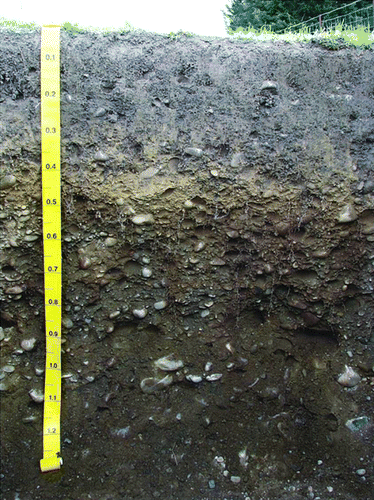
Figure 2 Overview of the Winchmore Irrigation Research Station during 1952 depicting the administration, laboratories and service buildings with the response of pasture to irrigation trial in the distance immediately adjoining the left-hand most buildings.
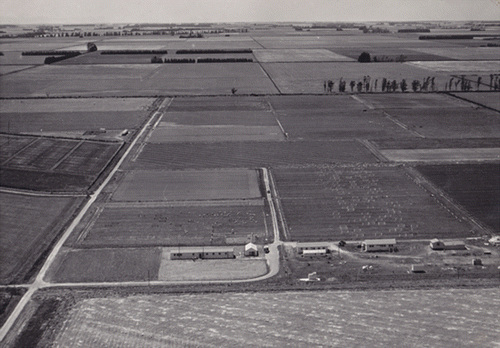
Table 1 Properties of Lismore stony silt loam.
Winchmore has a mean annual rainfall of 745 mm (range 491–949 mm), relatively uniformly distributed throughout the year with a mean of 62 mm/month (range 3–243 mm/month). Mean monthly temperatures range from 4.7°C in July to 15.8°C in January, and temperatures frequently exceed 25°C during the summer (December–February). Northwest winds of the Föhn type are frequent, giving rise to conditions of low humidity and occasionally high temperatures. The daily rate of calculated potential evapotranspiration during summer averages 3 mm. Winters are relatively cold, with ground frosts occurring on three days out of four (Rickard Citation1978).
Both these trials were conducted on border-strip irrigated soils. ‘Strips’ which were approximately 9 m wide, were formed prior to sowing by grading top soil to the sides of the strip to form raised ‘borders’ and levelling the soil between the borders (). Irrigation water flowed down the strip () at a mean application rate of 80–90 mm per application (Taylor Citation1985).
Response of pasture to irrigation
The area was ploughed out of run-out browntop (Agrostis sp.) in June 1947. It was summer-fallowed and bordered in February 1948, then sown in cereal green-feed with 125 kg/ha superphosphate. Ploughed in September 1948 and summer-fallowed after 5000 kg/ha lime in November 1948. Pasture was sown in March 1949 with 250 kg/ha superphosphate. Superphosphate was applied annually at a rate of between 190 and 250 kg/ha and at a rate of 1900 kg/ha lime in September 1953.
The area of approximately 2.4 ha was divided into 24 separately fenced border-strips each approximately 100 m by 9 m. There were originally six irrigation treatments in a randomised block design.
Trial 1
| 1. | No irrigation. | ||||
| 2. | Irrigated at weekly intervals. | ||||
| 3. | Irrigated at two-weekly intervals. | ||||
| 4. | Irrigated at three-weekly intervals. | ||||
| 5. | Irrigated at six-weekly intervals. | ||||
| 6. | Irrigated at three-weekly intervals, alternate seasons only. | ||||
Treatment 4 was intended to reflect the fact that, as water was supplied to farmers on a rostered system, a 21-day interval was considered the most like to reflect the farmers’ situation. The reason for treatment 6 is obscure; possibly it was considered that pasture would benefit from a second-year ‘rest’. These treatments were applied regardless of rainfall and as more information was obtained on the physical properties of the soil, it became obvious that some of the treatments should be based on soil moisture. From 1953/54 to 1956/57 the original treatments were replaced by trial 2.
Trial 2
| 1. | No irrigation. | ||||
| 2. | Irrigated when the soil moisture in the top 100 mm soil reached 50% available moisture. | ||||
| 3. | Irrigated when the soil moisture in the top 100 mm soil reached 0% available moisture (permanent wilting point). | ||||
| 4. | Irrigated at three-weekly intervals. | ||||
| 5. | Irrigated at six-weekly intervals. | ||||
| 6. | Irrigated at three-weekly intervals, alternate seasons only. | ||||
In both trials, pasture production was measured by a movable frame technique (Lynch Citation1966). There were two frames per plot and these were sampled separately, samples being taken for dry matter determination and herbage composition analysis. Herbage samples were retained for subsequent chemical analysis. Approximately 9–10 cuts were made each season. Soil samples (for gravimetric soil moisture) were taken two to three times a week on the appropriate treatments and soil samples for chemical analysis each year.
The above trial was closed and the area was grazed from September to November 1957 and no irrigation applied. From mid-November until the end of February, the area was top worked with a rotary hoe and grubber. Before sowing, the area was top dressed with DDT superphosphate at 140 kg/ha. Germination was excellent on all plots and uniformity cuts taken in August and September 1958 showed no significant differences between previously applied irrigation treatments.
Because of the residual effects of irrigation, the non-irrigated treatments could only be on the four previously non-irrigated plots. This meant that there could be five replicates of four irrigation treatments. In view of the likelihood of a different level of variation occurring among non-irrigated plots, the Biometrics Section of the Ministry of Agriculture and Fisheries considered that the area should be regarded as comprising two parts for trial 3.
Trial 3
Part A studied five replicates of a completely randomised design, treatments being
| 1. | Irrigated when the top 100 mm soil reached 10% moisture. | ||||
| 2. | Irrigated when the top 100 mm soil reached 15% moisture. | ||||
| 3. | Irrigated when the top 100 mm soil reached 20% moisture. | ||||
| 4. | ‘Rational’ 21-day irrigation interval. | ||||
Part B was four replicates of a non-irrigated treatment.
During the 1958/59 season, leakage from some headgates occurred and for this reason measurement of pasture production was discontinued for this season. The following season, standard mowing frames (0.9 m high, area approximately 4 m square) were replaced by lightweight electric frames 0.38 m high, the advantage being their lightness and cost. Their disadvantage was the unforeseen ability of sheep to jump the electric wire and safely graze inside the frame. Mowing records were again abandoned for the 1959/60 season and recommenced from the 1960/61 season. As funding was no longer available, measurement of pasture performance ceased during autumn 2004, but application of irrigation treatments has continued on trial 3.
More detailed information on trials 1 and 2 is available in Rickard (Citation1972) covering the years 1950 to 1957 and trial 3 in Rickard & McBride (Citation1986) covering 1960 to 1985.
Superphosphate requirements of irrigated pasture
This area was ploughed in winter 1948 out of a browntop (Agrostis spp.) pasture. After summer fallowing it was bordered and greenfeed sown in autumn 1949. The area was ploughed and again summer-fallowed before being sown to pasture (see for mix) in February 1950. Lime at 2.5 t/ha and 125 kg/ha superphosphate were applied with the greenfeed and a further 2.5 t/ha lime and 250 kg/ha superphosphate at sowing down. When the trial was commenced, the 2-year old pasture was perennial ryegrass (Lolium spp.) and white clover (Trifolium repens) dominant. During the trial, the treatments that received superphosphate remained predominantly ryegrass and white clover dominant.
Table 2 Pasture mixture sown at Winchmore in the 1950s.
Trial 1
The area of 2 ha was divided into 20 separately fenced border-strips and the following treatments applied on a randomised block design.
| 1. | No superphosphate. | ||||
| 2. | Superphosphate 188 kg/ha (autumn application). | ||||
| 3. | Superphosphate 376 kg/ha (autumn application). | ||||
| 4. | Superphosphate 564 kg/ha (autumn application). | ||||
| 5. | Superphosphate 376 kg/ha (split between autumn and spring). | ||||
To avoid possible transference of fertility, each main treatment was grazed by a separate flock of sheep, grazing management being aimed at an even and adequate control of growth. This was achieved by adjusting sheep numbers as required. Live weights were taken monthly and number of grazing days recorded.
As with the response of pasture to irrigation, pasture production was measured using exclusion cages (3.25×0.61 m), with two cages per plot (Lynch Citation1966). These areas were pre-trimmed to 25 mm above ground level, and left for a standard grazing interval for that time of year, before a 0.40 m wide strip in the middle of each enclosure was harvested to 25 mm above ground level using a lawnmower. The total wet weight was determined and a sub-sample taken to determine dry matter content and subsequently kept for later analysis. A sample within the harvested area was first cut with hand shears to 25 mm above ground level, and manually dissected into grass, clover and weeds. A new area was pre-trimmed on each occasion. All surplus mown herbage was returned to the plot. A composite soil sample of 10 cores (2.5 cm diameter) was collected from each plot to a depth of 7.5 cm. These were initially collected at 3-month intervals (July, October, January and April) but in the later years were collected either at 6-month intervals or annually (July) prior to fertiliser application.
Trial 2
Trial 1 ran from 1952/53 to 1957/58 when the original treatments were changed as follows.
| 1. | No superphosphate. | ||||
| 2. | Superphosphate 188 kg/ha autumn. | ||||
| 3. | No superphosphate (residual 376 kg/ha)*. | ||||
| 4. | No superphosphate (residual 564 kg/ha. | ||||
| 5. | Superphosphate 376 kg/ha*. | ||||
(*Two plots of each of these treatments were placed on the original treatments 3 and 5.)
These treatments ran from 1958/59 to 1979/80. Pasture production data were therefore available from areas receiving no superphosphate, 188 kg/ha and 376 kg/ha for 28 years, and the residual effects of 376 kg/ha and 564 kg/ha over 21 years. In addition, in 1958 a small-plot experiment was placed on treatments 1, 3 and 4. Treatments on this trial were as follows.
| 1. | Control. | ||||
| 2. | Mono-calcium phosphate (equivalent to 376 kg/ha superphosphate). | ||||
| 3. | Gypsum (equivalent to 376 kg/ha superphosphate. | ||||
| 4. | Treatments 2 + 3. | ||||
In 1977 a similar small-plot trial was placed on treatments that had received 188 kg/ha and 376 kg/ha for 25 years. These trials had a split-plot design with four replicates, with clippings returned.
Details of the results of the above trials can be found in Rickard (Citation1968a), Citation1968b) and Rickard & McBride (Citation1987).
Trial 3
In 1980 it was decided to introduce two new treatments: 250 kg/ha superphosphate and Sechura phosphate rock + gypsum (equivalent to 250 kg/ha superphosphate). Initially, in 1980, the Sechura treatment was in the form of ground Sechura RPR/gypsum pellets. The particle size of the RPR was 55% <0.075 mm. In 1981, 1982 and 1983, Sechura phosphate rock/elemental sulphur granules made from ‘as-received’ RPR mixed with molten S were applied at 22 kg P/ha and 27 kg S/ha. From 1984 a mixture of as-received Sechura phosphate rock and elemental sulphur (<2 mm) was applied. Two plots of each of these treatments were placed on each of treatments 3 and 4. The new treatments were therefore as follows.
| 1. | No superphosphate. | ||||
| 2. | 188 kg/ha superphosphate. | ||||
| 3. | 250 kg/ha superphosphate. | ||||
| 4. | Sechura rock phosphate and gypsum. | ||||
| 5. | 376 kg/ha superphosphate. | ||||
To rejuvenate the residual treatments, the sward was broken up by heavy trampling by sheep and then direct drilled with ryegrass and white clover in August 1980. Following this, an initial application of 850 kg/ha superphosphate and the equivalent application of Sechura/gypsum pellets (750 kg/ha) were applied to these residual treatments. This was calculated to raise the concentration of total inorganic phosphorus in the 0–75 mm depth to a level intermediate between treatments 2 and 5.
It was the intention to use commercially available superphosphate 0–9–0 throughout the trial on the assumption that there would be no changes to this locally manufactured product. Although registered at a total P of 9% to the nearest whole number, superphosphate made entirely from Nauru/Ocean Island phosphate rocks regularly tested at a little under 9.5% total P. However, from the late 1960s, progressive deterioration in the quality of the rock phosphate from Christmas Island, being used in place of the exhausted Ocean Island material in blends with Nauru phosphate, caused major manufacturing difficulties. The result was a significant reduction in the solubility of the phosphorus in the superphosphate and extremely poor physical quality that in many cases was only overcome by the addition of ground serpentine rock (a magnesium silicate mineral), as a granulating and conditioning agent. Throughout the 1970s the commercial phosphate treatment used on the trial was such an amended product known as ‘Flowmaster Super’ with a registered total P content of 8%. The product application rates on the trial were not adjusted so it is likely, therefore, that in this period the total P applications were reduced by approximately 15%. The quality of superphosphate was restored by the beginning of the 1980s, as manufacturing solutions to the problems of making good superphosphate from Christmas Island/Nauru Island rock phosphate blends were established and put into place (A. Duncan, Ravensdown Fertiliser Co-op. Ltd [retired], pers. comm., 2012).
This trial continues with full measurements and with the most recent application of treatments being applied during late winter 2011.
Operations at Winchmore
Equipment and techniques have changed over the duration of these trials. The initial grazing exclusion cages were wooden framed, constructed and painted by Winchmore staff (). They were substantial and required two people to shift, despite which the nor-west winds did blow some over. During the early 1960s they were replaced with a galvanised pipe framed version, which was much more robust and lighter meaning they could be shifted by one person. This task was much easier when using a locally invented set of wheels known as ‘Charlie’ () that was easily placed under an end of the frame allowing it to be moved in a similar fashion to a wheelbarrow. In typical New Zealand fashion the old frames were disassembled and made into farm gates.
Figure 5 Response of pasture to irrigation trial during 1954 with the wooden grazing prevention frames and each border-strip individually fenced. An identical layout was used on the superphosphate requirements of irrigated pasture trial.
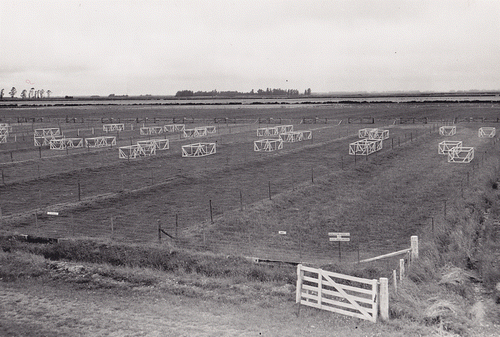
During the first 55 years of the trial, plots were harvested using a Dennis reel mower (). This was self-propelled and could travel at a very brisk walking pace when moving from plot to plot. This associated exercise was curtailed by one operator who attached a two-wheeled trailer on which he travelled. This was a well-made British machine that did a lot of work and only recently needed a replacement motor. It weighed about 150 kg and consequently required some skill to operate, especially doing the sharp turns that were needed to access plots. Such manoeuvres were not always well executed and there was the occasional entanglement with a fence or pasture cage.
Figure 7 The late John Baird doing a herbage yield measurement cut on the superphosphate requirements of irrigated pasture trial during the late 1950s.
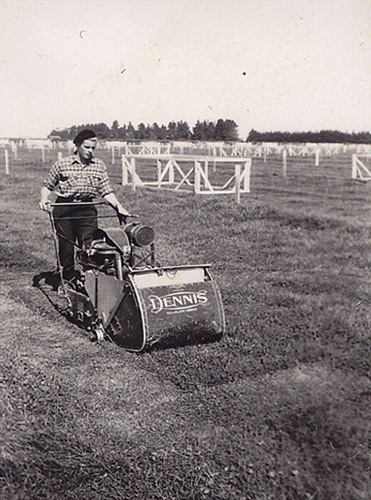
A range of top dressers was used over the years; to avoid applying too much fertiliser, they were calibrated to apply slightly less than the required amount. The deficit was then applied by hand—a technique that has not changed in 60 years. In the interests of accuracy of application it was vital that there was no wind during the application.
From 1952 to the present time, the fertiliser trial has been harvested 417 times yielding data from the equivalent of 8340 plots. Since 1958, the irrigation trial has been harvested 349 times with data from the equivalent of 8376 plots. Three scientists have done the majority of the supervision directly involved in these trials. There were, however, considerably more technical staff with over 27 directly engaged in field work and an additional 18 involved in herbage dry matter determinations and species analyses. Some decided this wasn't their career of choice and left after a few weeks, while others persevered for many years with one continuing to be intermittently involved over 50 years.
Although the original trials (response of pasture to irrigation (commenced 1949) and superphosphate requirements of irrigation pasture (commenced 1952)) were initially designed to provide results that would have practical applications for farmers working with irrigation, the fact that both trials (albeit with some modifications) have continued until 2011 means that they have provided a valuable resource for scientists working in many areas. These include pasture production, nutrient cycling, phosphorus, sulphur and potassium chemistry, reactive phosphate rock fertiliser, superphosphate, fertiliser quality and chemistry, irrigation, soil moisture and temperature, soil organic matter, nutrient and fertiliser decision support modelling, soil biology, DDT residues, cadmium and uranium accumulation and the relationships between pasture production, soil moisture and climate.
Acknowledgements
Although the trials were designed and supervised over the years by scientists, the main acknowledgement should go to the many technicians and farm staff at Winchmore who carried out the tedious, boring and vitally important routine analyses associated.
References
- Lynch PB 1966 . Conduct of field experiments . Wellington , New Zealand Department of Agriculture, Bulletin 399 . 155 .
- Rickard DS 1968a . Superphosphate requirement of irrigated pasture . Winchmore Irrigation Research Station , Christchurch , New Zealand . Technical report no. 1 .
- Rickard DS 1968b . The requirements and residual effects of superphosphate on irrigated pasture . Winchmore Irrigation Research Station , Christchurch , , New Zealand . Technical report no. 2 .
- Rickard DS 1970 . Effect of soil moisture and irrigation on pasture production in Canterbury, New Zealand . Proceedings of the XI International Grassland Congress, Surfers Paradise , Queensland , Australia . 487 – 492 .
- Rickard DS 1972 . Investigations into the response of pasture to irrigation. Winchmore Irrigation Research Station, Christchurch, New Zealand . Technical report no. 5 .
- Rickard DS 1978 . Meteorological data 1950–976 . Winchmore Irrigation Research Station , Christchurch , New Zealand . Technical report no 11 .
- Rickard DS , McBride SD 1986 . Irrigated and non-irrigated pasture at Winchmore, 1960 to 1985 . Winchmore Irrigation Research Station , Christchurch , , New Zealand . Technical report no 21 .
- Rickard DS , McBride SD 1987 . Long-term application and residual effects of superphosphate and effects of reactive phosphate rock on irrigated pasture . Winchmore Irrigation Research Station , Christchurch , , New Zealand . Technical report no. 22 .
- Taylor , AR , Aldridge , DG and Kermode , IM . 1985 . Farm design for efficient irrigation . Proceedings of the New Zealand Grassland Association , 46 : 31 – 36 .
